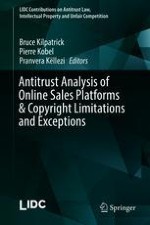2018 | OriginalPaper | Chapter
25. United Kingdom
Author : Eleonora Rosati
Published in: Antitrust Analysis of Online Sales Platforms & Copyright Limitations and Exceptions
Publisher: Springer International Publishing
Activate our intelligent search to find suitable subject content or patents.
Select sections of text to find matching patents with Artificial Intelligence. powered by
Select sections of text to find additional relevant content using AI-assisted search. powered by
